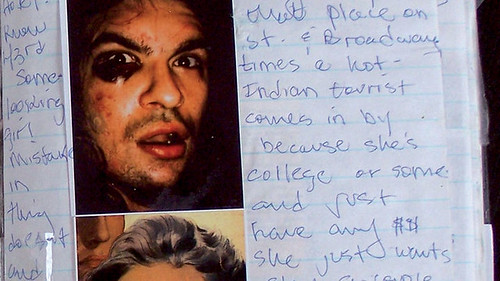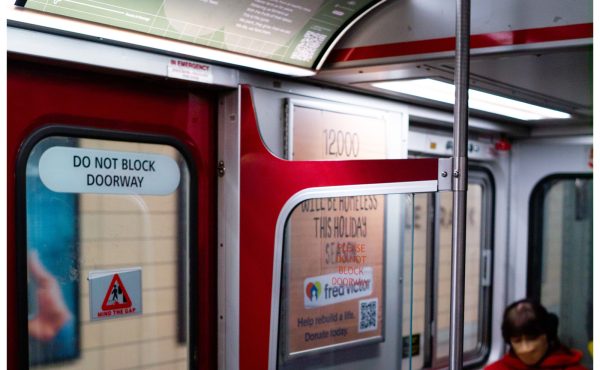
Like a strange peering glance through a keyhole into a world of rooms rented by the week in New York City of the eighties, Diary of a Times Square Thief uses the occasion of a newly discovered scrapbook to unearth a host of burnt out and jubilant New Yorkers and resurrect their memories.
The film opens with a matter of fact account of filmmaker Klaas Bense‘s EBay acquisition of the diary, a chronicle of a young poet’s efforts to establish himself in the City. The curling pages of the notebook he buys for seventy-five dollars are covered in a ball-point blue scrawl and interspersed with Polaroid snapshots of faces, some odd, some old, some beaten into new and bloody shapes. The last few pages are missing, apparently cut from the book with a knife.
Captivated by the voice in the pages, Bense travels to New York to excavate any traces that remain of the young writer, John, whose character is slowly teased out from the mouths of former guests and employees of the Times Square hotel where he worked. Some of the people Bense interviews remember John well, and some don’t, even though photos of their much-younger faces appear in the pages of his diary. We meet Mr. Cohan, psychic to the stars, and Mr. Joe Franklin, who sits all day at a tiny desk surrounded by a chaotic archive of papers, and we hear about the mobster who runs his organization of thieves (John among them) from a wheelchair in the men’s room of Penn Station. We chat with Ducky DooLittle, former Times Square sex worker, now a Harvard sex-ed lecturer, Sammy, once an urban accident-chasing reporter, now a photographer in war-torn countries, and Chet, the philosopher bartender who graduated from Columbia in the same class as Barack Obama, and drew his first welfare check the day Obama declared his presidential candidacy. In the past world that these characters shared, and which emerges from the memories and life-lessons they feel moved to reveal, murderers can be your best friends and lovers, and bizarre umbrella headgear can shield the shy face of the most skillful artist. Nothing is at it seems—especially not yourself.
Artfully keeping its secrets and doling out its surprises like a judicious chocolatier or fascinating parlour act, the film keeps viewers wondering until its final moments whether John might be the fabrication of everyone’s faulty memories of a heady New York, or if he disappeared in an excess of the little blue pills, or if he vanished as completely as if he had landed in an unmarked body bag by simply finding a new life somewhere else. With eight people a night being shot in the City at the time, people jumping frequently from the upper floors of the hotel, and HIV beginning to threaten the community, survival, friendship, personality, and memory, each begin to seem precious, fleeting, and rare.
New York City itself provides the crucial background to these discoveries in the search for John. The distinctive skyline bookends the film, with the camera first following a bubble against a building and then taking up its floating motion, to move slowly down to settle on a subway train. “You’re not really a New Yorker unless you can say this used to be that, and that use to be there,†says the philosopher Chet. “Eventually the city is half in your head, pretty much.†The film exposes precisely this city of memory, more or less painful, more or less worth keeping. Allowing the filmmaker Klaas Bense to climb inside one absent person’s experience of a former New York world, the abandoned diary becomes a roadmap to who John was once, and what he wanted to forget.
Diary of a Times Square Thief plays again today at 2 pm at Cumberland 2, and this Sunday at 7.30 pm at Innis Town Hall. For another documentary about life in a hotel on the margins of a city, check out Alison Rose’s Love at the Twilight Motel, playing this Saturday at 7.15 at the Royal.



